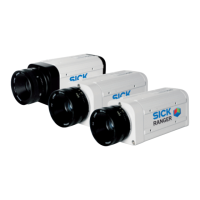Chapter 5 Reference Manual
Ranger E/D
60 ©SICK AG • Advanced Industrial Sensors • www.sick.com • All rights reserved
Configuring Ranger E and D
• The Coordinator calibration software available from SICK.
• A Ranger and laser properly set up to obtain good quality range measurements.
• A parameter file configured to give good quality range data.
o It is recommended (but not required) to use the same algorithms and set-
tings when generating the calibration LUT as when using it. If the object
you scan is very different from the calibration object in terms of reflec-
tiveness, color etc, you may need to modify the exposure time to get
properly exposed data from the calibration object.
o If the parameter file is set to use triggering or the enable signal, disable
these while generating the calibration LUT. If not you will have to trigger
and/or enable the camera to get data in the Coordinator tool.
• A calibration target suitable for the required field of view. Such targets can be or-
dered from SICK. You can also manufacture them yourself using CAD files pro-
vided by SICK.
Provided that the components above are in place the calibration procedure lasts only a
few minutes. The result is a LUT file which can either be saved to camera flash or stored as
a file on your PC.
For MultiScan setups containing several range components, each component needs to be
calibrated individually. There is currently no support for aligning the coordinate systems of
multi range setups. The easiest way to generate LUT:s for such a setup is to disable all
range components but one, then use the Coordinator tool to calibrate it and repeat this
procedure for each range component in the configuration.
To learn more about how to use the Coordinator tool, please refer to the Coordinator
Reference Manual.
Tools to use calibration LUT:s
This section applies to both Ranger and Ruler cameras. Using the calibration support
introduced in iCon 4.0 the same functions are used for both Ranger and Ruler cameras to
get calibrated and rectified data from the cameras into your application software.
There are two ways to use the previously generated calibration LUT:
1. By enabling the menu option ‘Show data calibrated’, Ranger Studio will show a
rectified version of the incoming data. This requires the calibration LUT to be
stored in camera flash. There is currently support for one such LUT being stored in
the camera so for multi range setups (available in Ranger E cameras) only the first
range component will be calibrated.
By using the calibration and rectification filter functions of the iCon API your vision applica-
tion software can calibrate and/or rectify data from a Ruler or Ranger camera. You can
also calibrate and/or rectify raw data stored as IconBuffers on file. See the chapter on the
iCon API for details on how to do all this. There are also example programs and a CHM
(help) file in the 3D Cameras SDK to show details on how to utilize this in your software

